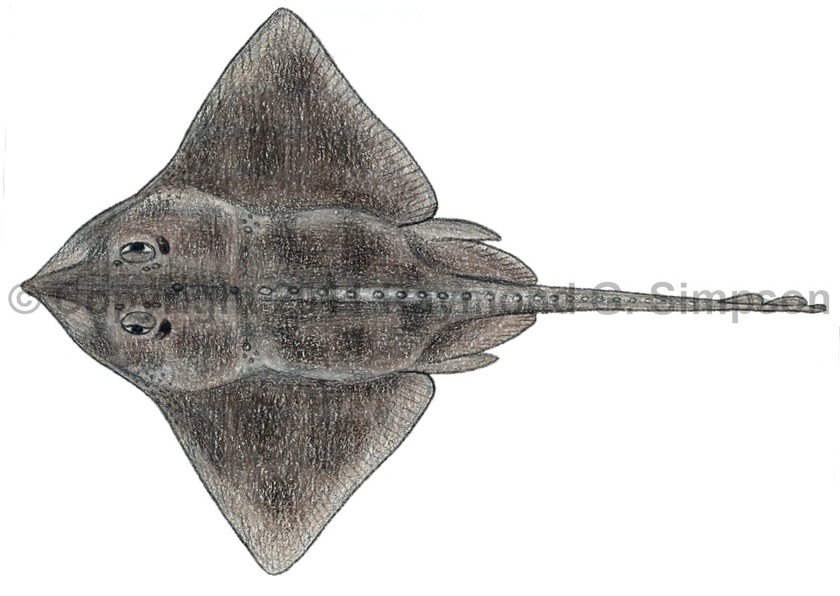
Common Name
Shorttail Skate
Year Described
Bigelow & Schroeder, 1950
Identification
Body relatively thick and heavy. Disk diamond-shaped with a concave anterior margin (more so in males). Snout fairly short. Rostral cartilage stiff. Eyes small. Pectoral fins angular to bluntly rounded. Pectoral skeleton does not reach snout tip, leaving a semi-translucent area adjacent to rostral cartilage. Anterior pelvic fin lobe much smaller than the posterior lobe and separated by a shallow notch. Tail is thickened, about 63% of TL, and has skin folds on both sides. There are two dorsal fins, separated from each other by a distance less than first dorsal base. The caudal fin is very small. Upper jaw with 52-66 tooth rows. Clasper very stout and broad.
Body covered with dermal denticles dorsally. Ventrum smooth. There are around 3-4 orbital thorns. There are 2-4 scapular thorns. There are 2 nuchal thorns. The abdomen and tail have a row of 20-31 thorns. Body thorns are very large, especially in young, with conspicuous stellate bases. Scattered small thorns on rest of body, including malar, alar patches (male), snout, base of pectoral fin, and bands on either side of tail. There are no thorns between the dorsal fins.
Color
Dorsum brown with a diffuse pattern of dark blotches and small white spots on disk; usually less contrasting than in the Arctic Skate that is sympatric with it. Tail is usually banded with dark brown above and below. Ventrum variable: ranges from almost completely dark gray in the central Atlantic with small white patches to whitish with gray edges and large gray blotches randomly spread over disk on the eastern and western edges of range.
Size
Maximum size to 112cm TL.
Habitat
Found at a wide variety of depths (160-2550m), but more common in deep waters. Captured in deeper water further south.
Range
Northwestern Atlantic: from Arctic Canada and Greenland to the Mid-Atlantic states.
References
Last, P.R., White, W.T., Carvalho, M.R. de, Séret, B., Stehmann, M.F.W & Naylor, G.J.P (Eds.). 2016. Rays of the World. CSIRO Publishing, Melbourne.
Orlov, A.M., & Cotton, C.F. 2015. New data on the rare deep-sea skate Amblyraja jenseni (Rajidae) from the North Atlantic Ocean. Journal of Ichthyology, 55(4), 478-496.
Other Notes
This species is very close to Amblyraja hyperborea in morphology and color pattern. May differ in number of tooth rows ( A. jenseni with more than 50). The variation in dark versus light belly specimens is quite variable over the range of the two species, with dark forms of A. jenseni almost totally dominating on the Mid-Atlantic Ridge but largely mixed with lighter-bellied forms over the rest of the range (Orlov et al., 2015). The variation of A. hyperborea in dorsal and ventral pigmentation is very high and coloration may not be a useful character for identification. A morphological and molecular study over the entire Atlantic range of this species is needed to determine if there are clades corresponding to two species, or if the two taxa are a single variable species.